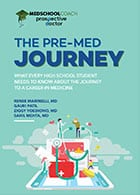
Table of Contents
The United States Medical Licensing Examination (USMLE) Step 3 is a crucial milestone for aspiring physicians in the U.S. Recently, significant changes have been announced for the passing requirements of this essential exam.
Effective January 1, 2024, the passing standard for Step 3 will increase, raising the three-digit score requirement from 198 to 200. This change, determined by the USMLE Management Committee, represents an adaptation to the evolving standards in medical education and practice.
Grasp the New Standards
The decision to adjust the passing score follows a comprehensive review process involving a national group of physicians, educators, and public members. This periodic review, which occurs every three to four years, aims to align the examination with current medical practices and patient care expectations.
This follows the decision to make USMLE Step 1 Pass/Fail in 2022, which caused shockwaves around the medical education world. A webinar from MedSchoolCoach covered the change in great detail, including how it affected the Residency Match Process.
The transition of USMLE Step 1 to a pass/fail system reflects a global educational shift towards reducing the emphasis on high-stakes testing. This change was motivated by the need to alleviate the immense stress and anxiety associated with the scoring of Step 1, which had significant implications for medical students’ mental health and well-being. Additionally, it aimed to foster a more holistic approach to medical education and evaluation, encouraging students to focus on broader learning and clinical competencies rather than just test scores.
No Expected Changes to USMLE Step 3 Format
Their are no expected changes to USMLE Step 3 at this time. The two-day examination is still structured to assess a candidate’s medical knowledge and understanding of clinical science necessary for the unsupervised practice of medicine.
Day one of Step 3 is a comprehensive evaluation spread over seven hours, inclusive of a 45-minute break. The test is segmented into six blocks, each lasting one hour and encompassing 38-39 multiple-choice questions (MCQs). This setup challenges candidates to demonstrate their proficiency in applying medical knowledge in various scenarios, necessitating both depth and breadth in their understanding of medicine.
Transitioning to day two, candidates face a more extended nine-hour session, again with a 45-minute minimum break. This day is designed to further probe the candidate’s medical acumen through 180 MCQs, organized into six blocks of 45 minutes each, containing 30 items per block. The unique aspect of the second day lies in the 13 case simulations, allocated 10-20 minutes each, designed to mimic real-life clinical situations. These case simulations, also known as Clinical Case Simulations (CCS), are a critical component, testing a candidate’s ability to make timely and effective decisions in patient care. A brief tutorial is provided before these simulations, offering insights into navigating this complex segment of the exam.
The USMLE Step 3 is not just a test of knowledge but an assessment of a candidate’s ability to apply their understanding in practical, real-world clinical situations. It’s an exhaustive but essential milestone in the journey of a medical professional, laying the foundation for a future in healthcare where critical thinking and decision-making are paramount.
Assess the Impact
Historically, the USMLE Step 3 exam has consistently demonstrated a high pass rate, instilling confidence in many medical students and residents as they approach this final hurdle. In the most recent testing cycle, the pass rate impressively stood at 97%, a testament to the thorough preparation and dedication of the examinees. This high success rate has been a source of reassurance for many, suggesting that with the right preparation and mindset, passing the Step 3 exam is well within reach for the majority of medical professionals.
However, with the introduction of new standards, a slight decrease in this pass rate can be anticipated, signaling a more challenging landscape for future examinees. This change will likely affect international medical graduates more than US medical graduates, as IMGs will typically take Step 3 during the residency application process.
The overall change continues to underscores the importance of being exceptionally well-prepared, as even a small dip in the pass rate can translate to a significant number of students facing setbacks. Being part of the minority who do not pass can have substantial consequences, potentially delaying medical licensure and impacting career opportunities. For IMGs, this will also impact match rates.
USMLE Step 3 Passing Rate FOR US GRADUATES
The table below illustrates the pass rates for USMLE Step 3 across various categories:
| Examinees From US/CA Schools | 2021 Number Tested | 2021 Percentage Passing | 2022 Number Tested | 2022 Percentage Passing |
|---|---|---|---|---|
| MD Degree | 22,225 | 97% | 22,336 | 97% |
| 1st Takers | 21,568 | 98% | 21,633 | 98% |
| Repeaters | 657 | 73% | 703 | 76% |
| DO Degree | 62 | 97% | 100 | 96% |
| 1st Takers | 61 | 97% | 98 | 96% |
| Repeaters | 1 | 2 | ||
| Total | 22,287 | 97% | 22,436 | 97% |
USMLE Step 3 Passing Rate FOR nON-US GRADUATES
| Examinees from Non-US/Canadian Schools | 2021 Number Tested | 2021 Percent Passing | 2022* Number Tested | 2022* Percent Passing |
|---|---|---|---|---|
| 1st Takers | 9,891 | 91% | 10,993 | 91% |
| Repeaters | 1,311 | 62% | 1,294 | 64% |
| Total | 11,202 | 87% | 12,287 | 89% |
MD and DO students who graduated from the US have a very high pass rate of 97% for USMLE Step 3. This should continue, even with the extra 2 point needed. IMGs typically have pass rates of ~91%, and the extra two points is expected to decrease this slightly.
What to Do if You Fail Step 3
As MedSchoolCoach, we understand that failing Step 3 can be a super stressful experience for any medical student or resident, but it’s important to remember that it’s not the end of your medical career. First and foremost, it’s crucial to take the time to reflect on the factors that may have contributed to the outcome, whether they are related to study methods, time management, or understanding of the material. We advise students to thoroughly review their score report to identify specific areas of weakness. It’s also beneficial to seek feedback from mentors or colleagues who can provide insights into your preparation approach. Then, develop a structured study plan, possibly incorporating new study resources or methods, and consider working with a tutor who specializes in USMLE preparation. Regular practice with question banks and simulated exams can also be immensely helpful. Remember, resilience and determination are key qualities in medicine, and overcoming this hurdle can ultimately make you a stronger, more competent physician.
Prepare Strategically
Preparing for the USMLE Step 3 exam requires an in-depth understanding of both its content and structure. This two-day exam includes a series of multiple-choice questions and computer-based case simulations. A key to success lies in being familiar with the exam’s format, particularly the case simulations that differ from standard multiple-choice questions, demanding a blend of clinical knowledge and decision-making skills.
An effective preparation strategy should encompass a detailed study plan that covers all relevant medical topics, while also allocating time for practicing case simulations and mock exams. This comprehensive approach is crucial, not just for knowledge retention, but for developing the critical thinking and problem-solving skills essential for excelling in the USMLE Step 3.
The Continued Importance of Step 2
In the evolving world of medical licensure examinations, recent changes have significantly altered the landscape. With the USMLE Step 1 transitioning to a pass/fail system, there has been a notable shift in the weight given to subsequent exams.
The USMLE Step 2 Clinical Knowledge (CK) has now emerged as a critical focus point for both students and residency program directors.
With the USMLE Step 1 now a pass/fail exam and the recent transition of Step 3 to a similar format, the significance of USMLE Step 2 CK has magnified exponentially. For residency program directors, especially in highly competitive fields like orthopedics, dermatology, interventional radiology, and urology, Step 2 CK scores have become a pivotal evaluative tool. This trend extends even to less competitive specialties, where the surge in residency applications, facilitated by virtual interviews, has made Step 2 CK scores a primary screening criterion. In this evolving landscape, it's imperative for medical students to not only pass Step 1 on their first attempt but to excel in Step 2 CK. Given these dynamics, it's unlikely that Step 2 CK will shift to a pass/fail system in the near future, underscoring the necessity for dedicated preparation and, where beneficial, targeted tutoring.
Dr. Sahil Mehta, MedSchoolCoach Founder
This shift elevates the importance of excelling in Step 2 CK, not just for passing, but for standing out in a competitive residency application pool. As Dr. Mehta emphasizes, thorough preparation and a strong Step 2 CK score are now more crucial than ever in a medical student’s journey.
Mastering USMLE Steps and Beyond
The recent changes in USMLE Step 1 and now 3, combined with the the critical role of Step 2 in medical licensure underscore the need for dedicated and strategic preparation. To navigate these challenges successfully, seeking expert guidance and support is a wise strategy. MedSchoolCoach offers specialized USMLE tutoring, tailored to your unique needs, as well as in-depth residency advising services. Our experienced tutors provide targeted strategies and insights, helping you focus on key areas to enhance your exam performance.
Choosing MedSchoolCoach to get a USMLE tutor boosts your chances of success in all aspects of the match and subsequent residency. This specialized support is vital to ensure you’re not among the small percentage who fall short of these new requirements and achieve high scores on Step 2. Contact MedSchoolCoach today for a consultation, marking a significant step in your journey towards a successful medical career.





